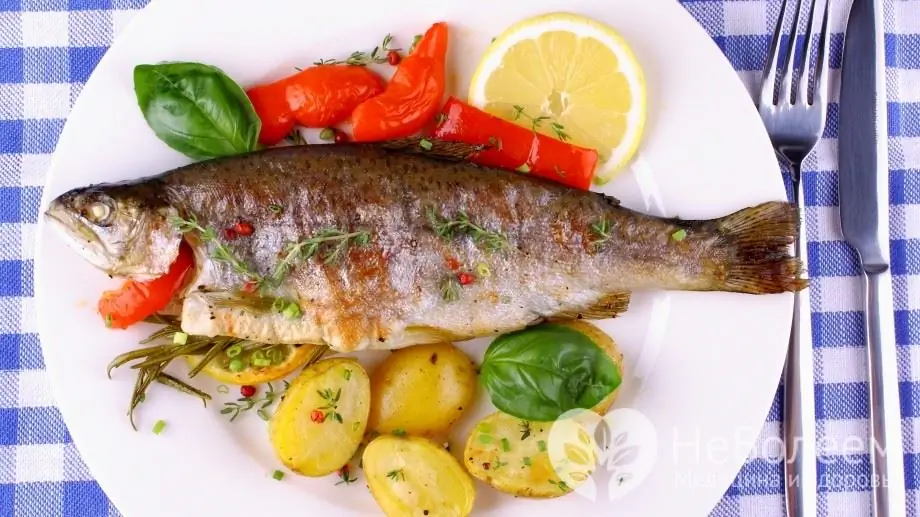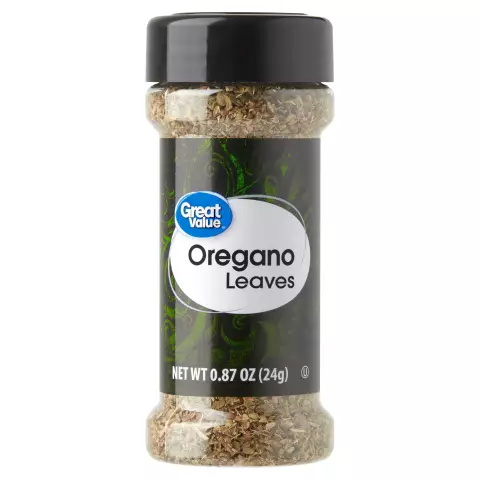- Author Rachel Wainwright [email protected].
- Public 2023-12-15 07:39.
- Last modified 2025-11-02 20:14.
Trout
Trout is a salmon fish. There are certain difficulties in classifying species of this genus due to the proximity and diversity of trout species. For example, river trout is often considered identical to lake trout. The fact is that this fish is characterized by significant variability depending on the conditions in which it finds itself.
The ratio of BJU in the product

Source: depositphotos.com How to burn 88 kcal?
| Walking | 22 minutes |
| Jogging | 10 min. |
| Swimming | 7 minutes |
| A bike | 13 minutes |
| Aerobics | 18 minutes |
| Household chores | 29 minutes |
Trout lives in rivers and streams mainly in mountainous areas, as they prefer clean waters rich in oxygen. Such fish is considered the most valuable in nutrition because of the surprisingly delicate taste and ecological purity of its meat. The extreme sensitivity of trout to water purity is used to assess the quality of water purification. The fish are launched to live in purified waters; in case of poor-quality cleaning, the trout dies.
Trout is also bred in special valley reservoirs and fish farms in order to obtain valuable meat and caviar. Some species do well in seawater. This fish feeds mainly on animal food - the larvae of various insects, worms, fry of other fish. Adults can feed on small fish and frogs.
The body of the trout is flattened on the sides, the muzzle is short, the color of the scales varies greatly - from olive green on the back to greenish yellow on the sides, with black and red or white spots surrounded by a bluish border. The abdomen is whitish-gray, sometimes with a coppery sheen. In general, the color of a trout can be darker or lighter depending on the color of the water and the bottom of the reservoir in which it lives. Also, the food and the season affect its color, for example, during spawning, as well as in bodies of water with muddy or peat bottom, trout becomes darker. It is known that the more fed the trout, the fewer spots on its sides. When moving fish from natural reservoirs to artificial ones, its color also changes.
The size of an adult river trout that is raised free depends on the size of the river where it is raised. On average, the length of fish reaches 25 - 35 cm, weight 300 - 500 g. In artificial reservoirs, larger specimens can be grown, up to 1.5 - 2 kg. They reach this weight in 2 years of life. Sea trout is larger than river trout.
Useful properties of trout
Trout meat is the richest source of easily digestible animal protein. The meat of freshwater species of this fish has a pinkish color, the color of the meat of sea trout approaches red.
The many essential amino acids that are included in protein metabolism determine the benefits of trout. The composition of trout will be especially valuable for people with anemia, diseases of the cardiovascular system, in the case of debilitating, long-lasting diseases.
Vitamin and trace element composition also determines the beneficial properties of trout. This fish is an important source of vitamins A, D, group B, as well as trace elements such as selenium, zinc, iodine, magnesium, potassium, calcium and phosphorus.
Trout meat contains a lot of unsaturated fatty acids that can reduce the amount of “bad” cholesterol in the blood, preventing the development of atherosclerosis and its complications such as coronary heart disease, as well as heart attacks and strokes.

The use of trout is to improve the functioning of the digestive and nervous systems, and the liver. People who regularly eat trout meat for food are three times less likely to develop cancer, depression and arterial hypertension.
It is known about the properties of trout to improve mood, restore vigor and strength after hard work, and increase the body's resistance to infections.
Calorie content of trout
In terms of calorie content, trout is inferior to other red fish, for example, salmon has 2 times more calories. 100 g of trout contains about 88 kcal, these figures may vary depending on the method of cooking the fish. But trout meat can be classified as dietary, and it is safe to include it in the diet of people with a tendency to be overweight.
YouTube video related to the article:
Found a mistake in the text? Select it and press Ctrl + Enter.






